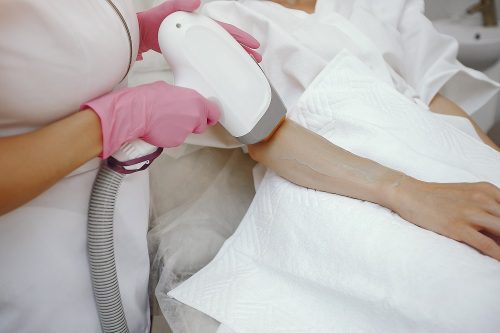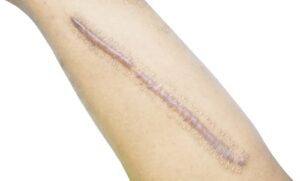Scars are visible reminders of the body’s ability to heal, but scars can also be a source of self-consciousness due to their high visibility depending on where they are on the body. Thanks to dermatological and medical advancements, laser scar removal has emerged as a highly effective method to reduce the appearance of scars. It has become the ideal choice for patients looking for surgery-free scar removal, and for doctors who prefer to offer their patients non-invasive scar treatment choices.
The Science Behind Laser Scar Therapy
In this comprehensive guide, we will discuss what laser therapy for scars is and how this cutting-edge technique is used for scar revision and reduction, especially when it comes to various types of skin types.
Laser scar removal is a non-invasive cosmetic procedure that uses laser technology to target and break down scar tissue. The procedure stimulates collagen production, promoting the growth of new, healthier skin cells and ultimately reducing the visibility of scars while also revitalizing the tone and appearance of the skin. This method is particularly effective for various types of scars, including acne scars, surgical scars, and injury-related scars.
Comparing Scar Treatment Options
Laser therapy for scars is not the only option, although it is the most preferred. There are an array of scar treatment options available including traditional methods such as topical creams, silicone sheets, and surgical procedures that have been used for years. Laser therapy offers a more targeted and less invasive alternative. Laser scar removal stands out for its ability to precisely target scar tissue without damaging the surrounding skin.
Tailoring Treatment to Skin Types
Laser therapy for scars involves the use of specialized lasers that emit light energy, targeting the pigmentation in scar tissue. The two primary types of lasers used in scar removal are ablative and non-ablative lasers. Ablative lasers remove the top layer of skin, promoting collagen production, while non-ablative lasers penetrate the skin without removing any layers, stimulating collagen growth beneath the surface.
Understanding Skin Types for Laser Scar Removal
Fractional laser therapy is a groundbreaking approach that treats only a fraction of the skin at a time, leaving surrounding tissues untouched. This allows for quicker healing and less downtime compared to traditional methods.
Combination Approaches for Scar Reduction
In addition to laser therapy, scar reduction procedures may involve a combination of laser treatments. Dermabrasion, chemical peels, and microneedling are often incorporated to enhance the overall efficacy of scar removal. A customized approach, taking into account the patient’s skin and scar characteristics, is key to achieving optimal results.
The Fitzpatrick Scale: Assessing Skin Typef
As with any topical skin treatment or procedure, it is important to consider the patient’s skin type when figuring out the best course of action. Different skin types react differently to treatments, and laser scar removal is no exception.
Skin types are commonly categorized into six classifications, known as the Fitzpatrick Scale, which was developed in 1975 by American dermatologist Dr. Thomas B. Fitzpatrick as a way to determine the skin’s reaction to ultraviolet (UV) light.
This scale helps skin doctors and professionals assess the risk of skin damage from sun exposure, which allows them to tailor treatments accordingly. The scale ranges from Type I to Type VI, with each type representing a different level of pigmentation and reaction to UV radiation.
Here’s a more detailed breakdown of each Fitzpatrick skin type:
1. Type I (Very Fair):
(A) Characteristics: Pale or white skin, often with freckles and light-colored eyes.
(B) Sun Response: Tends to burn easily, rarely tans.
(C) Examples: Individuals of Northern European descent.
2. Type II (Fair):
(A) Characteristics: Fair skin, light eyes, and hair.
(B) Sun Response: Burns easily, may gradually tan.
3. Type III (Medium):
(A) Characteristics: Light to medium-toned skin, often with brown hair and eyes.
(B) Sun Response: Sometimes burns, gradually tans.
4. Type IV (Olive):
(A) Characteristics: Olive or light brown skin, dark hair, and eyes.
(B) Sun Response: Rarely burns, tans easily.
5. Type V (Brown):
(A) Characteristics: Dark brown skin, dark hair, and eyes.
(B) Sun Response: Rarely burns, tans easily and significantly.
6. Type.VI (Very Brown or Black):
(A) Characteristics: Deeply pigmented brown to black skin, dark hair, and eyes.
(B) Sun Response: Rarely burns, tans deeply.
Consideration of Skin Types
Fair skin types (Type I and II) often respond well to laser therapy, as the contrast between the skin and scar tissue is more pronounced. However, individuals with darker skin tones (Type IV, V, and VI) should seek the expertise of a skilled practitioner to avoid potential pigmentation issues. Cutting-edge laser technologies, such as fractional lasers and picosecond lasers, have been developed to address the diverse needs of different skin types and make scar reduction procedures possible on those with darker skin tones, as long as the right settings are used.
The Importance of the Fitzpatrick Scale in Aesthetic Procedures
Understanding the Fitzpatrick Scale is crucial in aesthetic procedures, especially when it comes to scar removal and revision techniques. It will help the doctor assess the potential risks and benefits of various treatments based on a person’s skin type. For laser scar removal, consideration of skin type is essential to minimize the risk of complications such as hyperpigmentation or hypopigmentation, which may occur if the laser settings are not appropriately adjusted for the individual’s skin tone. Skin type and scar removal go hand in hand when trying to achieve optimal results.
Rejuvenate Your Skin: Book a Personalized Scar Removal Consultation Today!
When seeking laser scar removal or any other treatment of the skin, it is important to consult with a qualified practitioner who can ensure a personalized and safe approach to address individual skin characteristics and concerns.
Laser scar removal offers a promising solution for those seeking to minimize the appearance of scars and regain confidence in their skin. Understanding your skin type and consulting with a qualified doctor or laser specialist will ensure a tailored approach that maximizes the benefits of laser scar removal.
Book a consultation with the team at Fox Vein & Laser Experts and see how our Miami scar removal options can help you achieve your best skin ever. Call our office at 954-627-1045 or book an appointment online.
Related Links:
- Exploring Laser Scar Removal: What to Expect and Is it Right for You?
- What You Want to Know About Laser Scar & Acne Treatments?
- Types of Scars and Laser Treatment
- How Does the Miami Sun Affect the Healing Process of Scar Removal Treatments?
- Can a Dermatologist Remove a Scar?
- How Do You Treat Big Scars?
- How to Remove Unwanted Scars?


